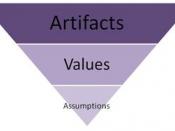IntroductionWhile research of corporate/organizational 'climate' looks at the link between individuals, groups, and performance experienced on a daily basis (communication, networking, reward systems, leadership styles), the term 'organizational culture' refers to the context in which these events occur.
Organizational culture (OC) is what a group learns over a period of time as it solves its problem of survival in an external environment and internal integration (Schein, 2000). Schein points out three areas where culture manifests itself: observable artefacts, values/norms, and basic underlying assumptions to which most researchers refer to. OC supports effective control (to regulate behaviour), normative order (to guide behaviour), promotion of innovation (in a culture that encourages creative thinking), strategy formulation, and employee commitment. Sackmann, Phillips, Kleinberg, and Boyacigiller (1997) suggest in that respect that cultural context contains greater regional, national, industry and regional level, and within the organization a functional, hierarchy and tenure level, that are influenced by gender, profession, ethnicity and religion.
Another aspect of OC highlights how well an individual fits an organizational context (O'Reilly, Chatmann & Caldwell, 2001). In this regard values and expectations of individuals interact with facets of the situation (incentive systems, norms) to affect the individual's attitudinal and behavioural responses. Furthermore OC-concepts guide OD and Change Management activities. The sustained interest in OC throughout the past decade has confirmed that, in order to understand and change an organization, a researcher must examine the linkages between underlying values, organizational structures, and individual meaning (Denison & Spreitzer, 2001).
In regard to the assessment of OC it is challenging that values/norms and basic assumptions influence behaviour on a subconscious level and are therefore not directly accessible for questioning or observation. Even the examination of artefacts and their meaning remains at first on a descriptive level (in the form of typologies), because terms of measurement...


